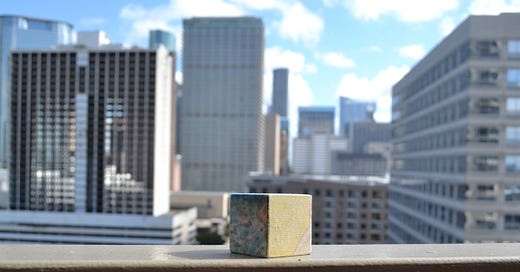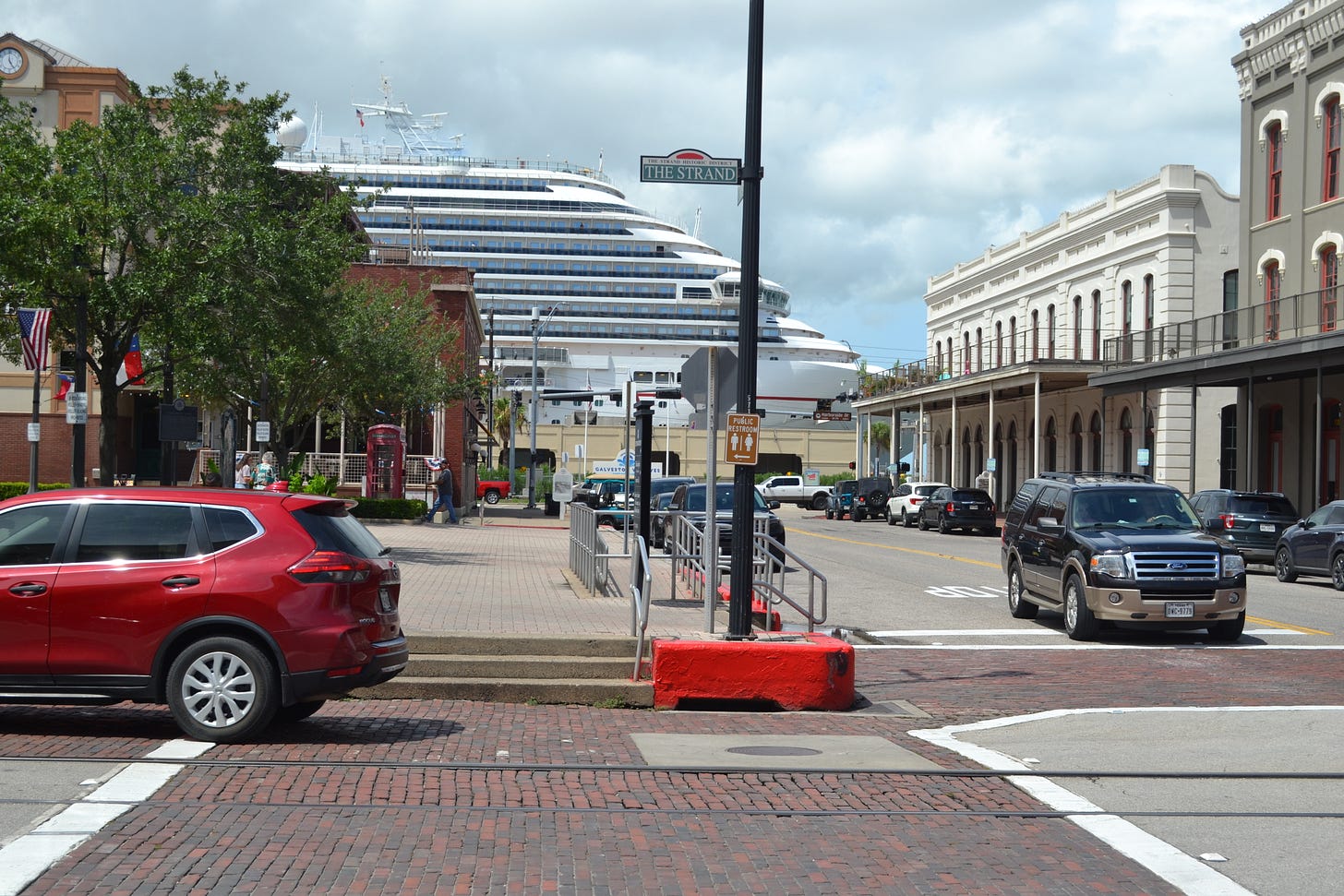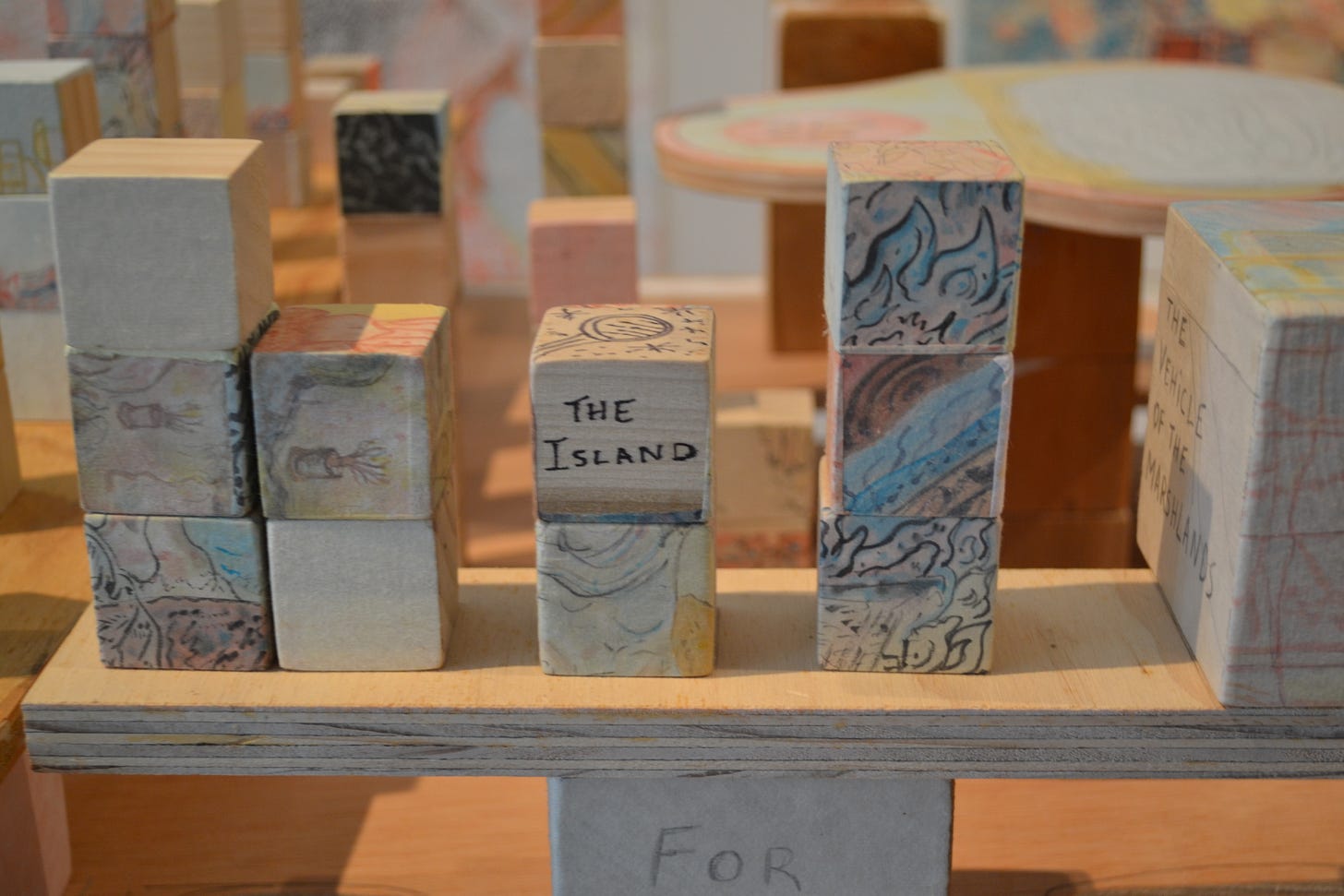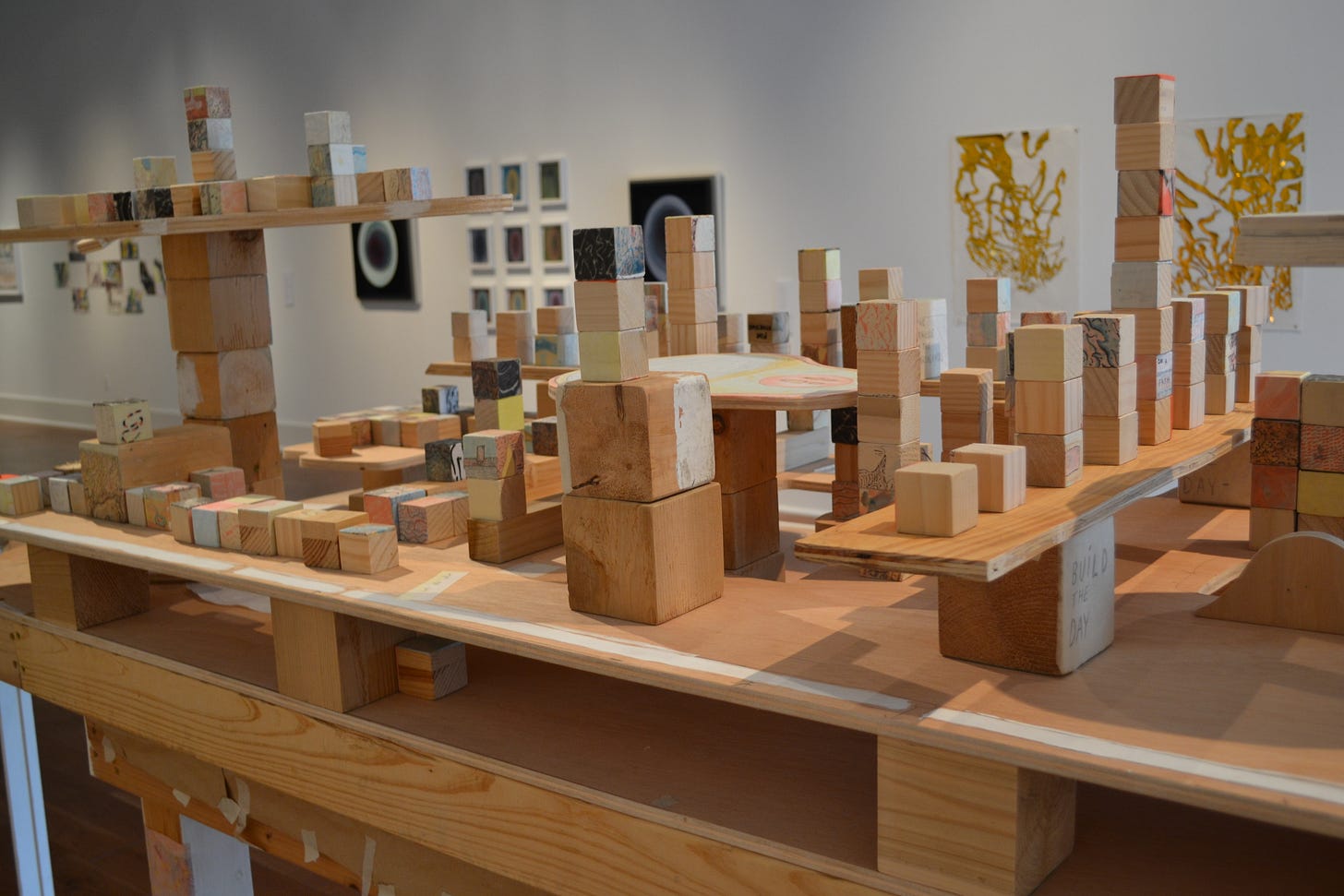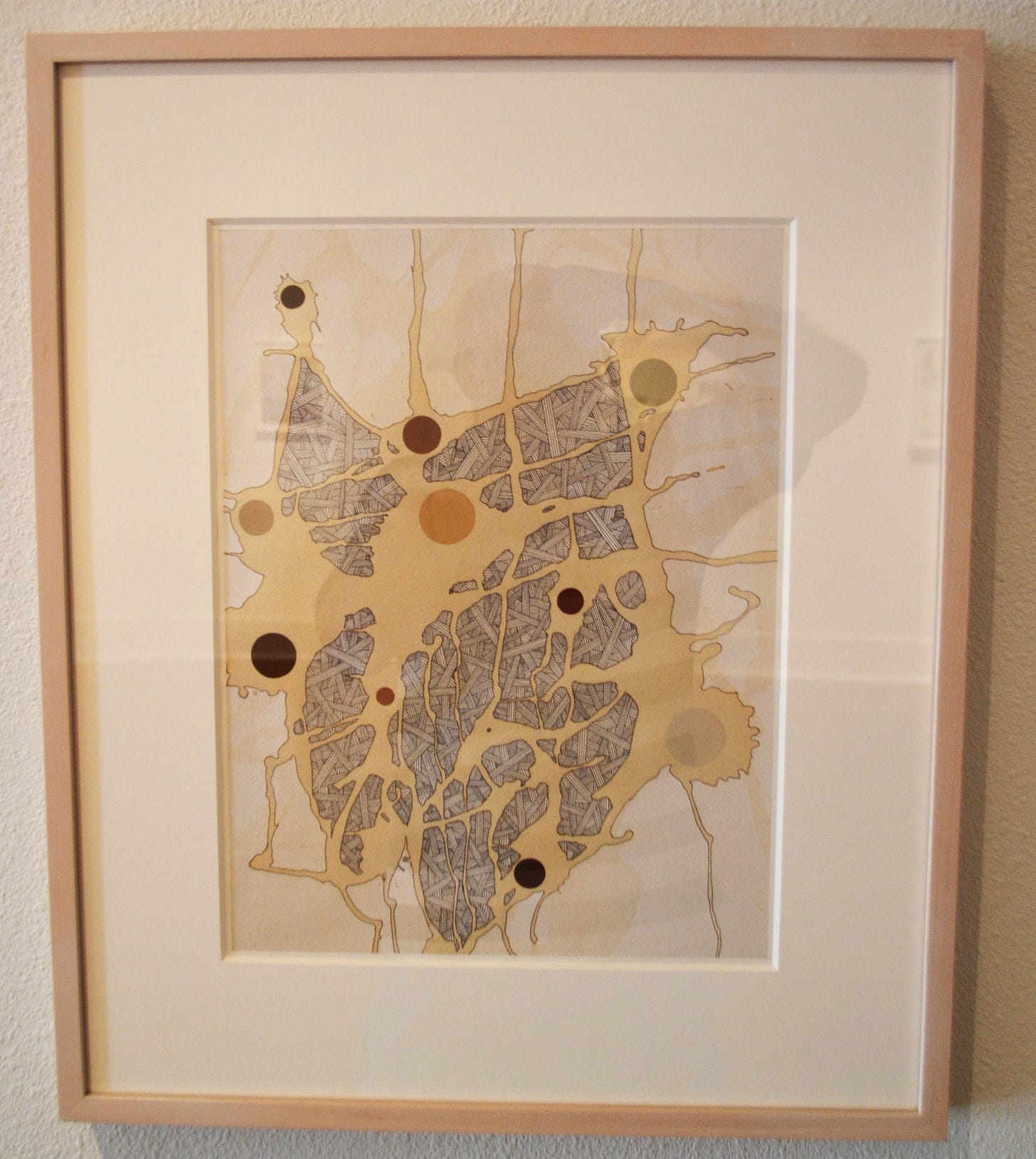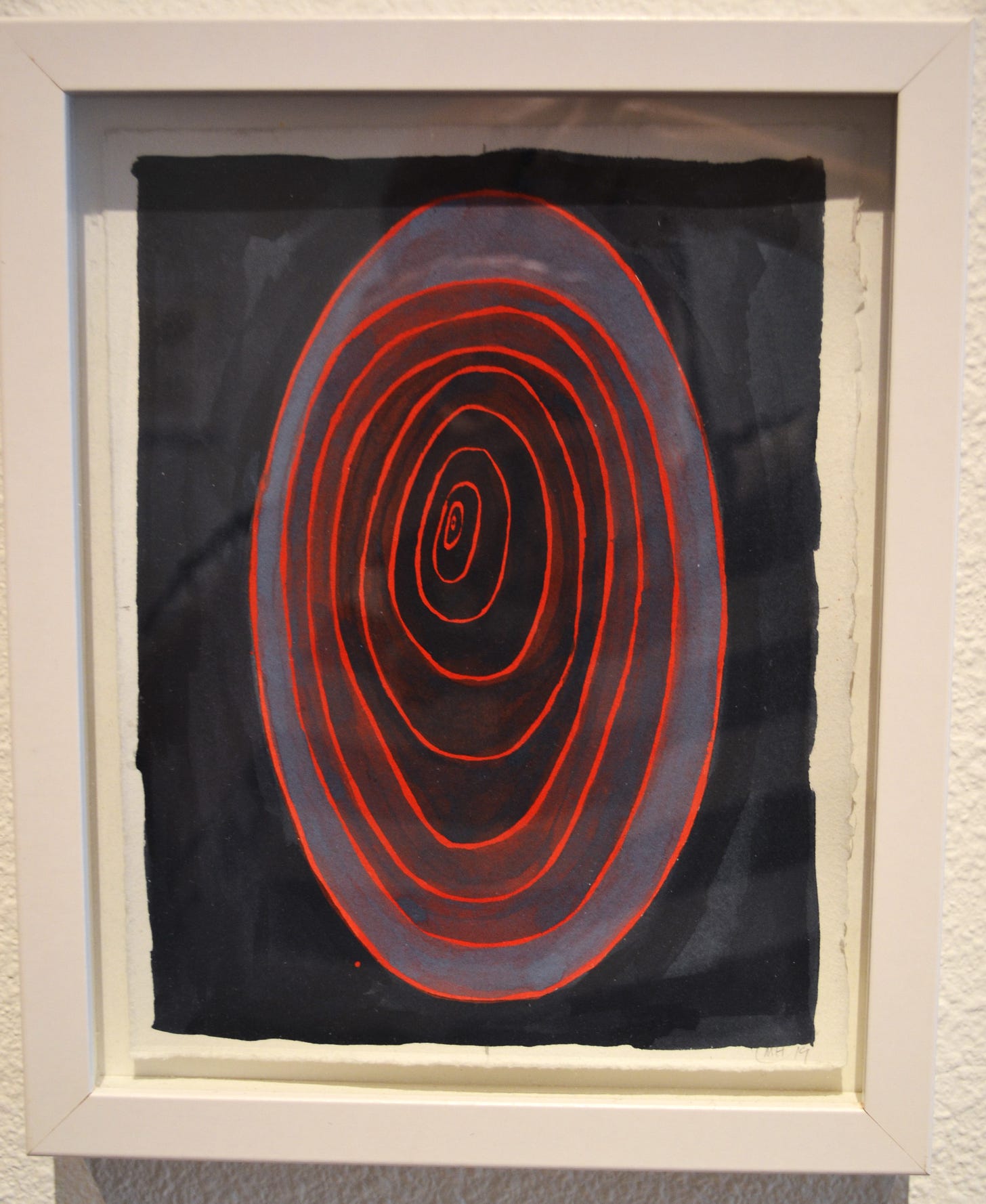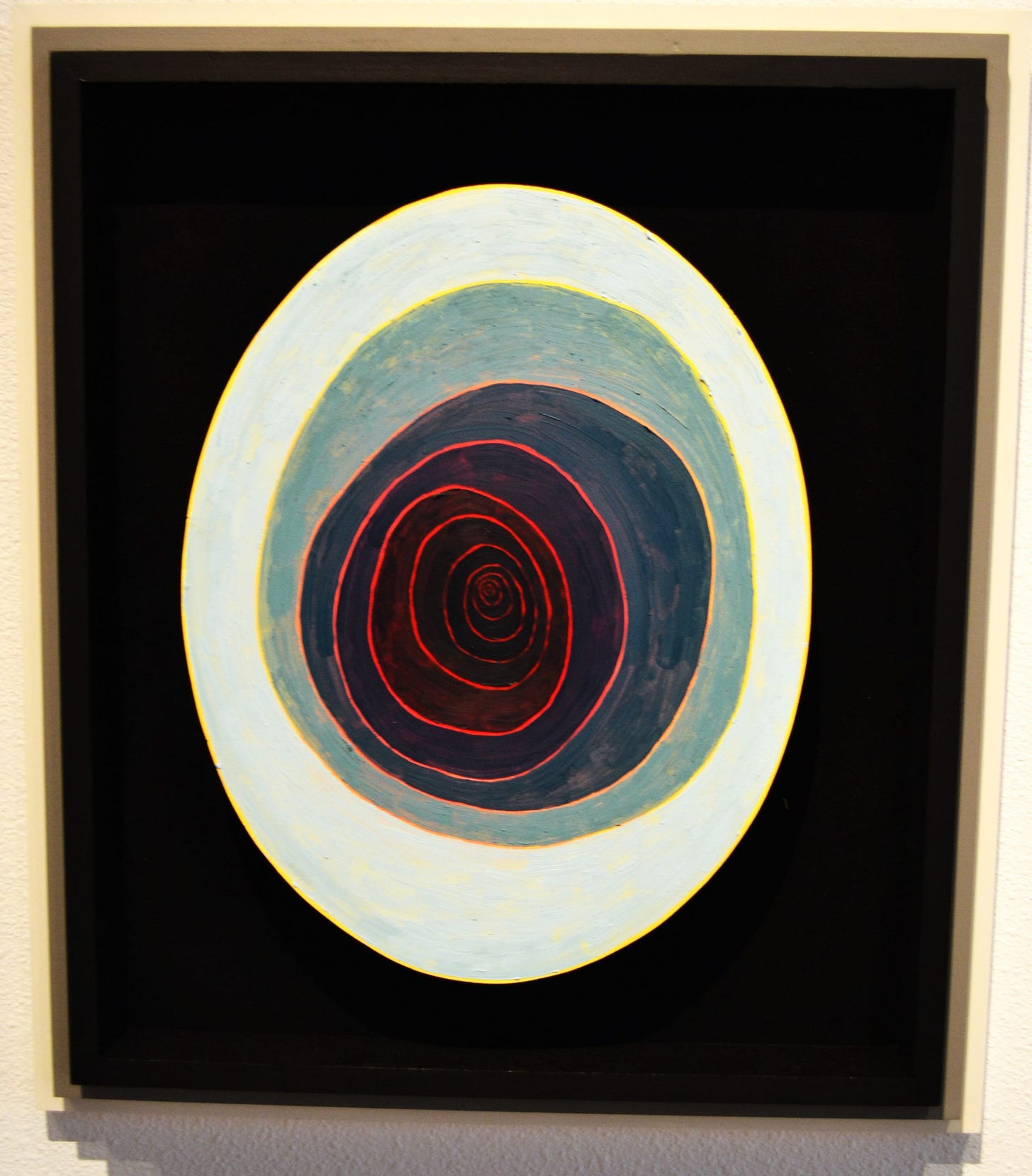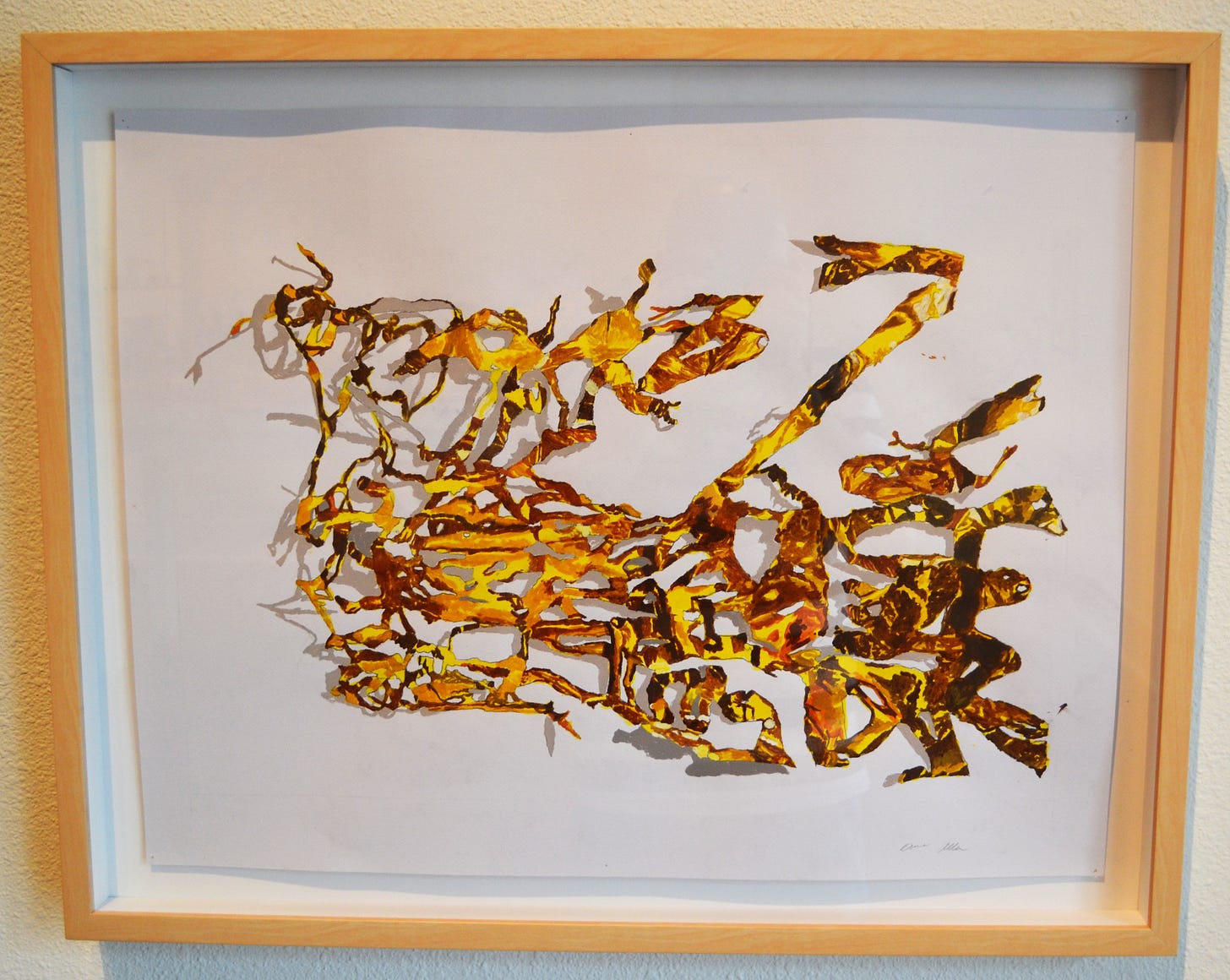Fantastic Voyages
I got this tiny wooden block as a gift the day before yesterday
It was created by Eric Schnell, who you might know as the founder and director of the Galveston Artist Residency. He is included in a group exhibit Along Those Lines on view now at the Galveston Arts Center. The description of the show states that features “six Texas-based artists whose work in drawing, painting, and sculpture draw connections to the landscape, mapping, and perceptions of the worlds we live in.” There is something map-like in much of the work, but Schnell’s work in this show is all about a particular Galveston reality, the looming behemoths that come into the Port of Galveston: cruise ships. There was one docked yesterday, which I took several photos of
Galveston is not a huge metropolis. It doesn’t have tons of large buildings. There are only three buildings that are bigger than the cruise ships on the island as far as I know: two condominium buildings on the beach that are each 27 stories high (same height as my apartment building, one of the most modest skyscrapers in downtown Houston), and One Moody Plaza (23 floors) located near the Strand in Galveston. The cruise ships are not nearly as tall, but they are impressively high and very, very long. Plus they can move. They sneak into port, disembark, fill up and slide away. While in port, they loom menacingly over the Strand.
I think these beasts that periodically show up in port are Schnell’s inspiration for Study for a Cruise Ship. Schnell does not attempt a realistic depiction: instead, he has two small wooden tables piled high with wooden blocks and planks, roughly approximating the rectangular shape of the ship. And this is one thing that makes these ships so unreal in Galveston—they don’t look like boats. They look like sleek mobile hotels. So if your task is to depict one, why not use blocks?
When I think of Galveston, I think of a grungy, somewhat louche place. The word “poetic” never enters my mind. But Schnell sees a Galveston I don’t. Aside from the cruise ship sculpture, his portion of the exhibit consists of somewhat gauzy watercolors. With titles like For Crossing the Shimmering Sea and We Arrived In the Fog, he addresses the romance and mystery of island living. And For Starting on Our Way to the Island of Umbellifers gives it a layering of the fantastic. Is Galveston the Island of Umbellifers? What are “unbellifers”?
This turn is continued on Study for a Cruise Ship. The wooden blacks Schnell used are painted with mysterious images (for example, of blue flames) and gnomic texts, like “from all this trampled ground, something new might arise.” While I see the worn-down ruin that is Galveston, Schnell lays on top of it a kind of magic. I don’t want to call him a civic booster, but his art and vocation display a love for the mostly hidden magic of the place

I find magic in maps. I love seeing information about how humans live revealed through maps. The Houston Arrow is such a map. Anyone who looked at wealth patterns, racial patterns, voting patterns has seen this arrow. Essentially it shows how within Houston, there is an arrow-shaped collection of census tracts, precincts, etc., that shows racial and wealth segregation in Houston. It’s an aspect of Houston that cannot easily be apprehended without a map. In a sense, this is what this exhibit is all about, although they aren’t maps of particular places (as far as I can tell). Schnell’s direct reference to Galveston is the exception
Kathleen McShane does draw landscapes of a sort, but like maps, they have words on them. But unlike maps, the words aren’t the names of the places (necessarily); they are descriptive yet punny. They are words that are physically part of the landscape. In this way, her pieces reminded me a little of one of my favorite childhood books, The Phantom Tollboth. The hero, Miles, travels to Digitopilis and Dictionoplis, the latter of which is full of places made of words. The KnowLedge is a ledge (a cliff) looking out over a landscape labeled “Information”. She is placing “knowledge” on a level higher than mere “information’, which does imply that above the knowledge cliff there may be an even higher cliff capped “Wisdom”. (Except I can’t make a map/landscape-based pub on “wisdom”)
But McShane’s work also will recall for some viewers Dana Frankfort’s word paintings. They have a superficial similarity—the words have a rough-hewn, hand-made feel to them. This isn’t calligraphy. But all of McShanes words are also paintings of places. Thenlands is the word “then” and an indistinct plane, as if you are seeing it from an airplane. Narrative Detective displays a hillside in which the words of the title are exposed
Perhaps it comes from a lifetime of reading fantasy novels, but these seem to be somewhat abstract locations on an imaginary map. And because of a lifetime of reading fantasy novel, McShane’s approach is especially appealing

Charles Mary Kubricht’s collage takes up almost the entire rear wall. What is displayed is a grid of small square works on linen. The linen is painted black and has white marks on the pieces. The grid is 12 linen squares x 12 linen squares. The title is We Are All Visitors and the information label says this is a detail. So perhaps Kubricht has made many more of these little black squares
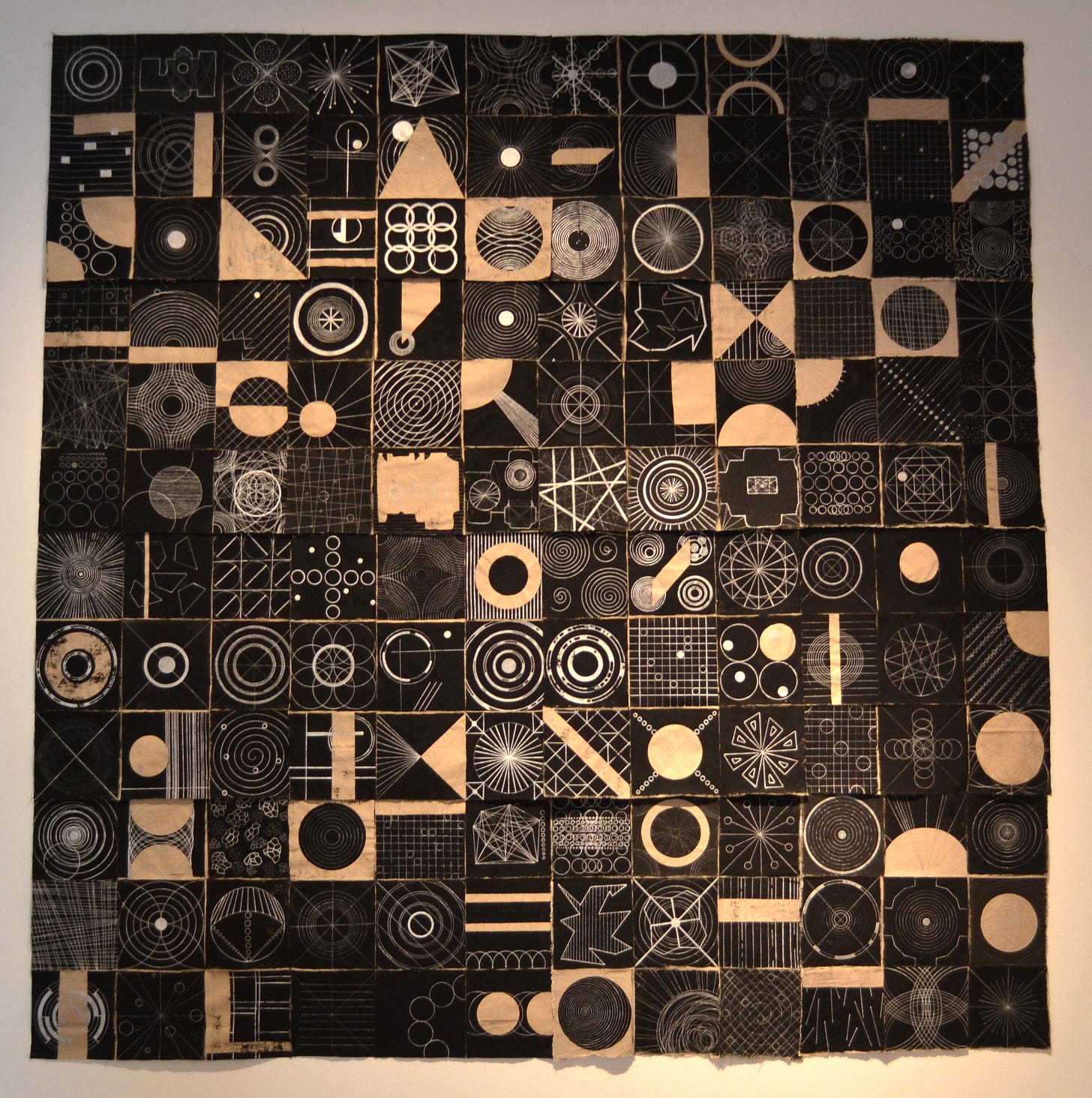
They look like scientific or mathematical diagrams. And because they are hand-painted white on black, they give the impression of things drawn on a chalkboard. They feel like they are left over from a mysterious classroom, taught by a professor with a remarkably steady hand
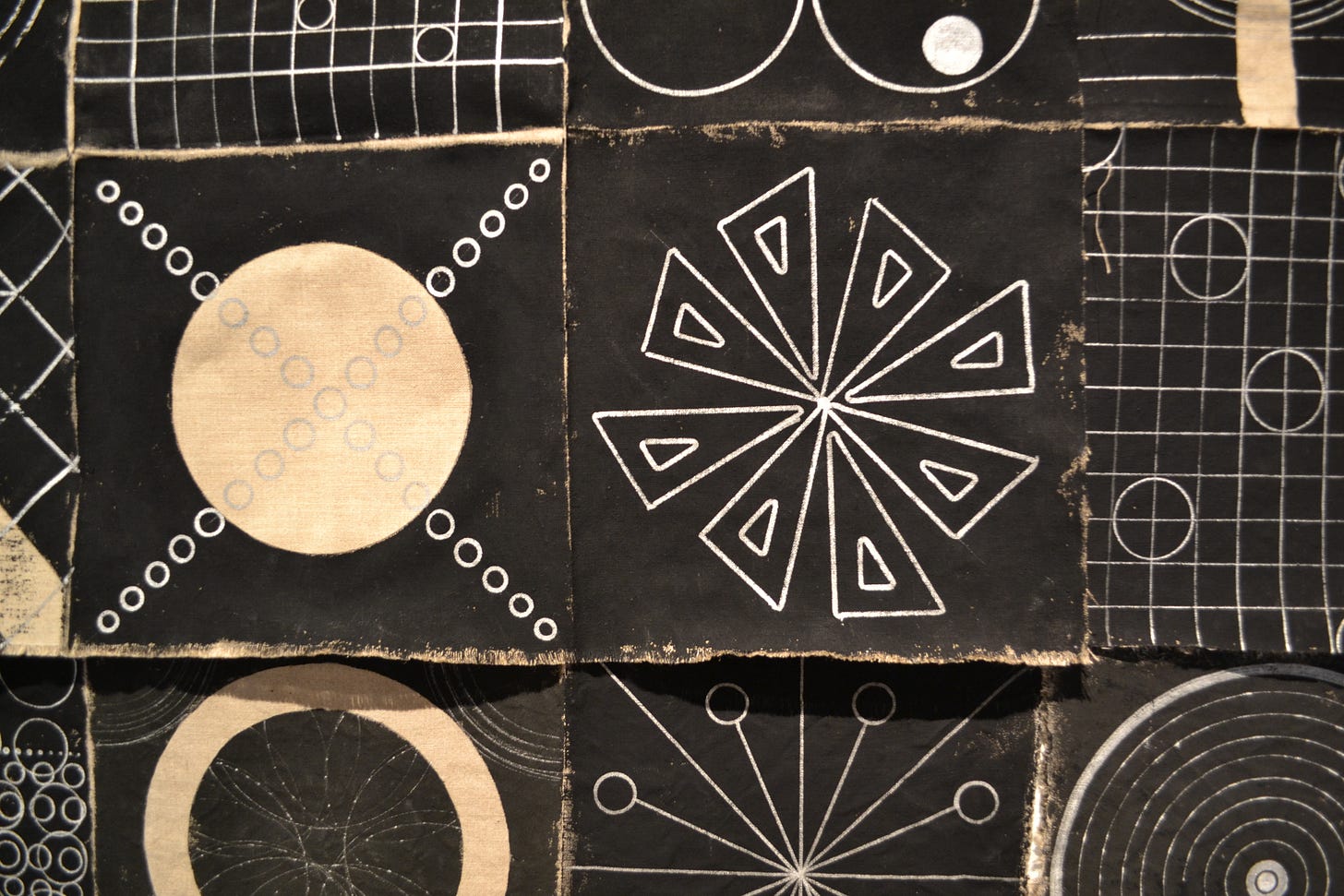


Randy Twaddle is familiar to Houston art lovers—I’ve been seeing his work for years over at Moody Gallery. Twaddle often draws telephone lines, power lines and transformers, often in silhouette and with coffee stains overlaid on them. The pieces in this exhibit use coffee stains, but are abstract. In a way, it seems like he’s pouring coffee on the paper first and then using the shape of the coffee stain as the basis for a composition. So why include them in a show about maps and place? Because even if they aren’t maps, they look like maps
They look like municipal maps, but not road maps. They are more like the maps that researchers and sociologist use (like the Houston Arrow map). The spots and shapes could represent socio-economic zones or flood plains or superfund sites, etc. My experience looking at Twaddle’s work is that he is an artist concerned with the urban world. And these abstractions fit right in
Michael Henderson is the chair of the art department at Sam Houston State University in Huntsville. This small state university has an unusually good art department—well worth the trip to Huntsville to check out. Although I’ve seen Henderson’s work for years, the only thing I can say about it is that he seems obsessed with tunnels. And his work in this exhibition continues his obsession. Here he depicts tunnels as ovals inside other ovals, getting darker the deeper you go
The smaller gouache drawings are all called SOTS (which makes me think of Komar and Melamid, who as unofficial artists in the Soviet Union invented “SOTS Art”, a combination of socialist realism and pop art, but I assume there is no connection here), and the two paintings on either end are called Passage 2 and Passage 3. All tunnels are passages of a sort. You go through them to get someplace else.
Anne Allen’s work does not have an obvious relationship to “place”. Her work feels more abstract, without obvious reference to anything. But I’m hesitant to say this—often what looks completely abstract has some connection to the world that the artist knows but the viewer doesn’t. But at least one of her pieces has a very specific connection to a place. Road Ribbon Mural Mockup I is literally a study for an actual mural, of which there is a photo on Anne Moore’s website. The website doesn’t specify where the mural is.
Tunnels, maps, chalk board, place names—they have a connection to the world and yet are also capable of being locations of pure fantasy and magic. Along Those Lines consists of five fantastic journeys. Well worth the drive from Houston to Galveston to see.
[Please consider supporting this publication by becoming a patron, and you can also support it by patronizing our online store. And one more way to support this work is to buy books through The Great God Pan is Dead’s bookstore. ]

